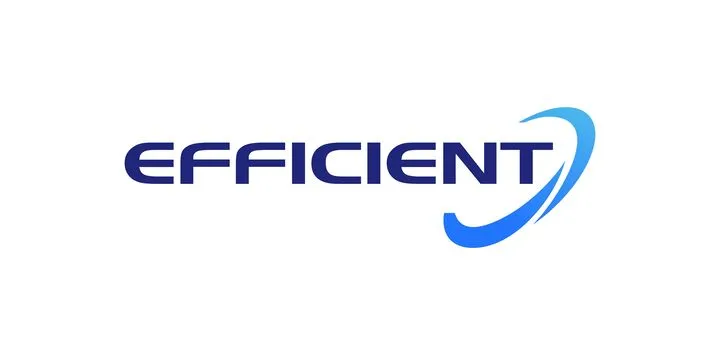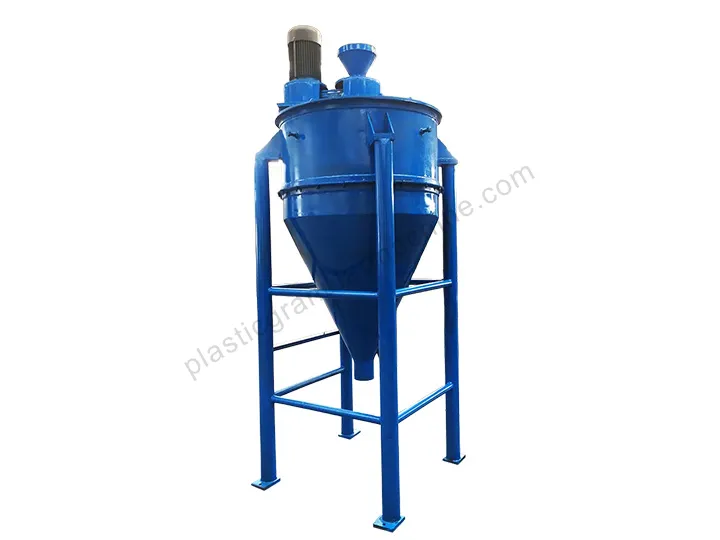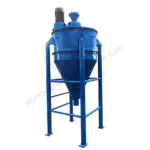Fiber Separator: Improve the Purity of Rubber Crumb
| Name | Fiber Separator |
| Infeed Materials | Ground rubber powders |
| Final Products | Higher-purity rubber powder |
| Capacity | 800-1000 kg/h |
| Services | On-site installation and operation guides |
| Warranty | One year free |
You can now ask our project managers for technical details
The fiber separator is an essential piece of equipment for any serious tire recycling operation. It is specifically engineered to address the critical stage of purification after the initial shredding and granulation. By integrating this machine into your line, you move from producing basic crumb to manufacturing a high-quality, specified raw material.
This isn’t just about cleaning; it’s about precise quality control that directly impacts your bottom line.
Key Advantages for Tire Recyclers
- Go Beyond ‘Clean’—Achieve Verifiable Purity: This fiber separator is designed to remove over 99% of fiber contaminants. This level of purity isn’t just visually noticeable; it’s a verifiable specification that allows you to confidently sell your rubber powder to more demanding markets.
- Produce High-Grade Material for Better Applications: Ultra-clean rubber powder is the key ingredient for higher-value end products. It’s essential for creating durable molded goods, consistent athletic surfaces, and high-performance rubberized asphalt, opening up more profitable revenue streams.
- Ensure Consistent Output, Batch After Batch: Manual or less efficient separation methods lead to inconsistent quality. The fiber separator automates the process, guaranteeing a uniform, high-purity output every hour of operation. This consistency is what builds a reputation for reliability with your customers.
- Built for the Demands of a Recycling Plant: We understand that recycling operations are demanding on machinery. That’s why this machine is built with heavy-gauge steel and a powerful, reliable motor. It’s designed for continuous use with minimal downtime.
The Science of Separation, Made Simple
The working principle behind our fiber separator is powerful yet straightforward. It uses air to sort materials by their weight and density—a method that is both highly effective and low-maintenance.
- Feed the Mix: The mixture of rubber crumb and fiber fluff from your granulator is fed into the top of the separation tower.
- Create an Upward Air Column: A powerful fan generates a precisely controlled column of air moving upwards through the tower.
- Sort by Weight and Density: As the material falls, the magic happens. The heavier rubber granules are too dense to be lifted by the air and continue to fall straight down, exiting through a discharge port at the bottom.
- Extract the Fiber: The lighter, fluffier fibers are easily caught by the upward air current, carried to the top, and channeled out into a separate cyclone collection system.
The result is two distinct, clean streams of material: pure rubber powder and separated fiber.
Technical Specifications Of Our Fiber Separator Machine
The SL-1000 is our best-selling fiber separator, with key specifications listed below. Simply inform us of your production requirements, and we will provide a customized equipment solution.
| Specification | Parameter |
|---|---|
| Model | SL-1000 |
| Motor Power | 5.5 KW |
| Motor Speed | 760 r/min |
| Capacity | 800-1000 kg/h |
| Dimensions (L*W*H) | 1500*1500*3400 mm |
| Weight | 1600 kg |
Frequently Asked Questions (FAQ)
1. Why is removing fiber so critical for recycled rubber powder?
Fiber acts as a weak point in final products. Removing it results in stronger, more durable materials. It also ensures better bonding when the rubber is mixed with other agents like asphalt or polyurethane binders.
2. Can this machine handle the fluff from both car and truck tires?
Absolutely. The system is highly effective at removing the different types of textile and nylon fibers found in both passenger car tires and heavier commercial truck tires.
3. How much maintenance does the machine require?
The design is intentionally simple to minimize maintenance. Routine tasks include checking the motor and fan bearings and periodically emptying the fiber collection unit. It’s built for maximum uptime.


